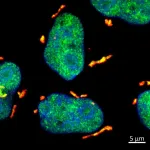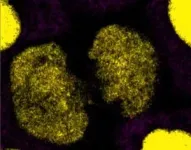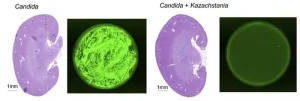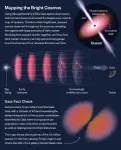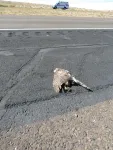(Press-News.org) Mothers and daughters have a strong bond, yet do you know that connections reminiscent of this close relationship extend all the way to the cellular level? During the process of cell division, new daughter cells inherit a mix of genetic material and other molecules from their mother cells. This inheritance includes both beneficial components, which can help them for a robust start in life, and potentially harmful mutations or damaged molecules, posing significant challenges for the newly born daughter cells. How daughter cells manage and mitigate the effects of harmful inheritance has remained a mystery. A study from the Max Planck Institute of Immunobiology and Epigenetics, Freiburg has now revealed a sophisticated mechanism by which daughter cells safeguard themselves against UV-damaged RNA inherited from mother cells.
As the sun's rays touch our skin, they bring warmth and vitality. Yet, beneath this gentle embrace lies a potential threat: ultraviolet (UV) radiation, the most energetic component of sunlight. Although we're familiar with how UV damages DNA and can lead to skin cancer, its impact on another vital molecule, RNA, often goes unnoticed.
While testing the cellular response to various stressors, researchers noticed something intriguing: after UV radiation, a protein called DHX9 gathered into droplet structures within the cell's cytoplasm. “DHX9 is an enzyme that normally resides in the nucleus and has the ability to bind RNA. Finding this protein forming droplets outside the nucleus left us really astonished. It's like finding a giant snowball in the desert,” says Asifa Akhtar, Director at the MPI of Immunobiology and Epigenetics in Freiburg.
Unravelling the Mystery of DHX9 Granules
Since UV radiation is widely known to cause DNA damage, the researchers initially suspected that these DHX9 granules act as a defence mechanism against such damage. “Contrary to this hypothesis, we found that DHX9 granules were not triggered by various forms of DNA damage stimuli. And this prompted us to dig into the real trigger,” says Yilong Zhou, the study's first author. Therefore, the team developed a groundbreaking droplet extraction method to isolate these granules directly from cells and analyze their content.
Surprisingly, the team found that the DHX9 granules, as a special type of stress granule, were packed with damaged RNA. “The damaging effect of UV light on RNA is frequently underestimated, overshadowed by its impact on DNA. Now, we discovered an elegant mechanism by which cells can segregate and neutralize harmful UV-damaged RNA with the help of DHX9 granules,” explains Asifa Akhtar. When cells detect RNA damage induced by UV exposure, they rapidly trap the damaged molecules into DHX9 granules, thereby preventing them from causing further harm. This safeguarding mechanism effectively confines the damage and ensures that it doesn't spread uncontrollably within the cell causing further chaos.
A Safeguard Mechanism in Daughter Cells
“What fascinated us even more was the observation that cells with DHX9 granules always appeared in pairs, indicating that they are not formed in the original UV-damaged mother cell but later on in the newly born daughter cells,” says Yilong Zhou. The hypothesis is confirmed by live cell video imaging. “You can literally see that DHX9 normally resides in the nucleus, but shortly after cell division, when the two daughter cells have formed, it gathers into droplets in the cytoplasm,” Zhou continues. Interestingly, preventing DHX9 granule formation in daughter cells leads to severe cell death, highlighting the ability of daughter cells to spot and stash away their progenitors’ damaged RNA into DHX9 granules. “This process is like wiping the slate clean, preparing them to begin their own journey as a cell without dragging along the baggage from the previous generation,” says Asifa Akhtar.
Understanding how our daughter cells defend themselves against UV-induced parental RNA damage not only deepens our understanding of the cell cycle but also opens up new possibilities for medical research. Conditions such as sunburn, neurodegenerative disorders, and cancer are intricately tied to disruptions in RNA balance and irregularities in the cell cycle. “A better understanding of how a newly generated cell selectively recognizes and degrades damaged RNA could lead to new therapeutic targets for diseases characterised by RNA mismanagement or dysregulation of the stress response,” explains Asifa Akhtar.
END
How DHX9 stress granules protect daughter cells from UV-induced RNA damage
Harm sealed, daughters saved – RNA damage compartmentalization by DHX9 stress granules
2024-03-18
ELSE PRESS RELEASES FROM THIS DATE:
Discover BMB 2024 press materials available now
2024-03-18
Embargoed press materials are now available for Discover BMB, the annual meeting of the American Society for Biochemistry and Molecular Biology. Top scientists and educators in the field will gather at the meeting, March 23–26 in San Antonio.
Reporters are invited to attend an exciting lineup of in-person scientific sessions in San Antonio or access press materials electronically. Register now or find more information in the #DiscoverBMB newsroom. Please note that only a limited number of complementary on-site press passes will be issued, so advance registration is recommended.
Explore the schedule at a ...
Newly identified yeast could prevent fungal infections by outcompeting rivals, study suggests
2024-03-18
Researchers at the Weizmann Institute of Science in Israel have identified a yeast that could be used to prevent invasive candidiasis, a major cause of death in hospitalized and immunocompromised patients. The study, to be published March 18 in the Journal of Experimental Medicine (JEM), shows that the novel yeast lives harmlessly in the intestines of mice and humans and can displace the yeast responsible for candidiasis, Candida albicans.
Millions of microbial species live within or on the human body, many of them being harmless or even beneficial to human health. The microscopic yeast C. albicans is commonly found in the intestines ...
NIH studies find severe symptoms of “Havana Syndrome,” but no evidence of MRI-detectable brain injury or biological abnormalities
2024-03-18
EMBARGOED FOR RELEASE
Monday, March, 18,2024
10 a.m. EDT
Contact:
NIH Office of Communications and Public Liaison
NIH News Media Branch
301-496-5787
NIH studies find severe symptoms of “Havana Syndrome,” but no evidence of MRI-detectable brain injury or biological abnormalities
Compared to healthy volunteers, affected U.S. government personnel did not exhibit differences that would explain symptoms
Using advanced imaging techniques and in-depth clinical assessments, a research team at the National Institutes of Health (NIH) found no significant evidence of MRI-detectable brain injury, nor differences in most clinical measures compared to ...
Clinical, biomarker, and research tests among US government personnel and their family members involved in anomalous health incidents
2024-03-18
About The Study: In this exploratory study, there were no significant differences between individuals reporting anomalous health incidents and matched control participants with respect to most clinical, research, and biomarker measures, except for objective and self-reported measures of imbalance and symptoms of fatigue, posttraumatic stress, and depression. This study did not replicate the findings of previous studies, although differences in the populations included and the timing of assessments limit direct comparisons. ...
Neuroimaging findings in US government personnel and their family members involved in anomalous health incidents
2024-03-18
About The Study: In this exploratory neuroimaging study, there were no significant differences in imaging measures of brain structure or function between individuals reporting anomalous health incidents and matched control participants after adjustment for multiple comparisons. U.S. government personnel stationed internationally have reported anomalous health incidents, with some individuals experiencing persistent debilitating symptoms.
Authors: Carlo Pierpaoli, M.D., Ph.D., of the National Institute of Biomedical Imaging and Bioengineering in ...
Can used coffee grounds help clean up environmental toxins?
2024-03-18
Global coffee consumption generates millions of tons of spent coffee grounds each year, which can be damaging to wildlife and the environment. However, new research published in the Journal of Chemical Technology and Biotechnology reveals that spent coffee grounds could be repurposed to act as a powerful adsorbent of bentazone, a herbicide commonly used in agriculture that is highly neurotoxic.
In the study, investigators found that when they used zinc chloride to activate the carbon from spent coffee grounds, the activated carbon showed a 70% efficiency in bentazone removal. ...
Largest-ever map of universe’s active supermassive black holes released
2024-03-18
Astronomers have charted the largest-ever volume of the universe with a new map of active supermassive black holes living at the centers of galaxies. Called quasars, the gas-gobbling black holes are, ironically, some of the universe’s brightest objects.
The new map logs the location of about 1.3 million quasars in space and time, the furthest of which shone bright when the universe was only 1.5 billion years old. (For comparison, the universe is now 13.7 billion years old.)
“This quasar catalog is different from all previous catalogs in that it gives us a three-dimensional map of the largest-ever volume of the universe,” says map co-creator David Hogg, a ...
Despite protection urban hawks still face an array of threats
2024-03-18
Life can be hard for a raptor. If you’re a teenager from the city, it’s even harder. That’s according to a new study published in the Journal of Raptor Research titled “Causes of Death of Female Cooper’s Hawks (Accipiter cooperii) from an Urban Setting in New Mexico, USA,” conducted by Brian A. Millsap and his colleagues at the US Fish and Wildlife Service. Over the course of 11 years, his research team affixed GPS transmitters to 158 female Cooper’s hawks in the Albuquerque area. Of those, 88 died and were found, allowing the researchers to investigate cause of death. The ...
Middle-aged Americans lonelier than European counterparts
2024-03-18
Middle-aged adults in the U.S. tend to report significantly higher levels of loneliness than their European counterparts, possibly due in part to weaker family ties and greater income inequality, according to research published by the American Psychological Association.
“Loneliness is gaining attention globally as a public health issue because elevated loneliness increases one’s risk for depression, compromised immunity, chronic illness and mortality,” said lead author Frank Infurna, PhD, an associate professor of psychology at Arizona State ...
Dr. Sujuan Ba and the National Foundation for Cancer Research have been awarded the 2024 Pioneer in Medicine Award at the 21st Annual GFC Awards Gala
2024-03-18
The National Foundation for Cancer Research (NFCR) is proud to announce that both the organization and our CEO, Dr. Sujuan Ba, have been honored with the "2024 Pioneer in Medicine Award" by the World Brain Mapping Foundation and the Society for Brain Mapping and Therapeutics. The award was presented to Dr. Ba at the 21st Annual GFC Awards Gala on Friday, March 15th, 2024. This recognition highlights a significant landmark in NFCR's over 50 years of impact in charting new pathways through research to find ...
LAST 30 PRESS RELEASES:
When is it time to jump? The boiling frog problem of AI use in physics education
Twitter data reveals partisan divide in understanding why pollen season's getting worse
AI is quick but risky for updating old software
Revolutionizing biosecurity: new multi-omics framework to transform invasive species management
From ancient herb to modern medicine: new review unveils the multi-targeted healing potential of Borago officinalis
Building a global scientific community: Biological Diversity Journal announces dual recruitment of Editorial Board and Youth Editorial Board members
Microbes that break down antibiotics help protect ecosystems under drug pollution
Smart biochar that remembers pollutants offers a new way to clean water and recycle biomass
Rice genes matter more than domestication in shaping plant microbiomes
Ticking time bomb: Some farmers report as many as 70 tick encounters over a 6-month period
Turning garden and crop waste into plastics
Scientists discover ‘platypus galaxies’ in the early universe
Seeing thyroid cancer in a new light: when AI meets label-free imaging in the operating room
Neutrophil-to-lymphocyte ratio may aid risk stratification in depressive disorder
2026 Seismological Society of America Annual Meeting
AI-powered ECG analysis offers promising path for early detection of chronic obstructive pulmonary disease, says Mount Sinai researchers
GIMM uncovers flaws in lab-grown heart cells and paves the way for improved treatments
Cracking the evolutionary code of sleep
Medications could help the aging brain cope with surgery, memory impairment
Back pain linked to worse sleep years later in men over 65, according to study
CDC urges ‘shared decision-making’ on some childhood vaccines; many unclear about what that means
New research finds that an ‘equal treatment’ approach to economic opportunity advertising can backfire
Researchers create shape-shifting, self-navigating microparticles
Science army mobilizes to map US soil microbiome
Researchers develop new tools to turn grain crops into biosensors
Do supervised consumption sites bring increased crime? Study suggests that’s a myth
New mass spec innovation could transform research
Maternal nativity, race, and ethnicity and infant mortality in the US
Migration-related trauma among asylum seekers exposed to the migrant protection protocols
Jupiter’s moon Europa has a seafloor that may be quiet and lifeless
[Press-News.org] How DHX9 stress granules protect daughter cells from UV-induced RNA damageHarm sealed, daughters saved – RNA damage compartmentalization by DHX9 stress granules
